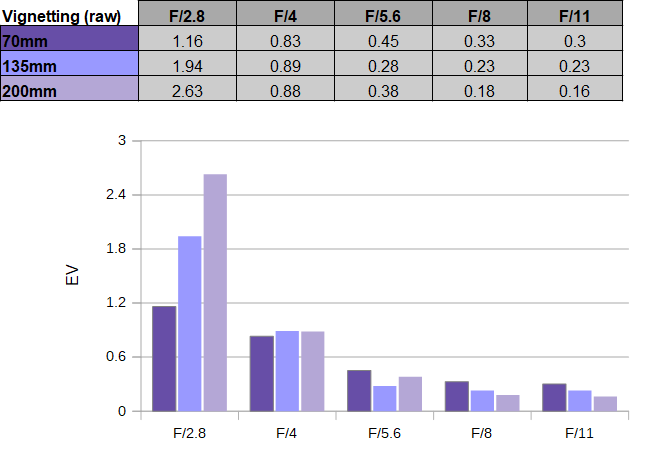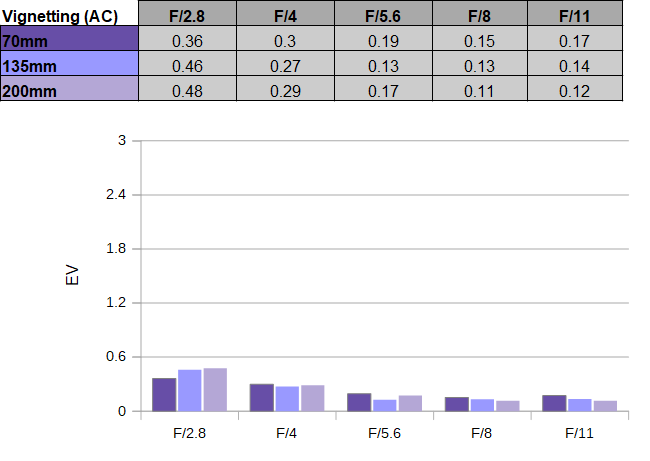|
Canon RF 70-200mm f/2.8 USM L IS - Test Report / Review - Analysis |
|
Lens Reviews -
Canon EOS (Full Format)
|
|
Page 2 of 3

Distortion
The Canon RF 70-200mm f/2.8 USM L IS produces only slight image distortions - for a mirrorless lens anyway. In uncorrected images, you may be able to spot a slight barrel distortion (1.2%) at 70mm. In the medium to upper zoom range, they are changing to pincushion type.
You have, of course, the option to auto-correct the distortions either in-camera or in your favorite RAW converter. In this case, you have nothing to worry about anyway - see below.
Vignetting
The vignetting characteristic is quite interesting - or in other words: it is a bit of a weakness. In uncorrected images, the vignetting is still moderate at 70mm f/2.8 (~1.2EV / f-stops). However, the light falloff increases when zooming toward longer focal lengths. The peak is reached at 200mm with a vignetting of ~2.6EV (f-stops) which is whoppingly heavy for a tele lens. The issue is substantially reduced at f/4, though and pretty much gone at f/5.6.
 Once again, if you prefer to activate image auto-correction, the algorithm takes care of all this resulting in a very slight vignetting at maximum aperture (at the cost of increased corner noise due to the signal amplification).
Once again, if you prefer to activate image auto-correction, the algorithm takes care of all this resulting in a very slight vignetting at maximum aperture (at the cost of increased corner noise due to the signal amplification).

MTF (resolution)
The Canon RF 70-200mm f/2.8 USM L IS is extremely sharp across the range - although it's worth mentioning that the Canon EOS R (used as a test camera) isn't overly ambitious with its 30-megapixel sensor. The broader image center is excellent straight from f/2.8 and the outer image field is on a very good level. Stopping down to f/4 lifts the quality even further with a superb center and excellent borders. Diffraction has a limiting effect beyond f/8 but at f/11 it'll be hard to notice. As usual, you should avoid stopping down to f/16 and beyond.
The centering quality of the tested sample was very good. The field curvature is very low.
Please note that the MTF results are not directly comparable across the different systems!
Below is a simplified summary of the formal findings. The chart shows line widths per picture height (LW/PH) which can be taken as a measure of sharpness.
If you want to know more about the MTF50 figures, you may check out the corresponding Imatest Explanations

Chromatic Aberrations (CAs)
Lateral CAs (color shadows) are very low with an average pixel width of less than 1px at the image borders. Lateral CAs can also be auto-corrected without any loss in image quality.

Bokeh
The sharpness is one thing but what about the quality of the out-of-focus blur aka "the bokeh"? Let's have a look at out-of-focus highlights first.
As you can see below, the highlight discs are nicely rendered with no outlining and a very smooth inner zone. This is almost of prime lens level! The circular disc shape remains intact at f/4 and there are only traces of an edgy aperture shape at f/5.6
 While the discs are perfectly circular in the broader center zone, they deteriorate towards the borders/corners of the image field. This is a normal vignetting effect and pretty much unavoidable. As you can see, there are cat eyes in the image corners at f/2.8. Stopping down to f/4 corrects this a bit and the discs are almost restored at f/5.6.
When looking at the general quality of the blur in the focus transition zone, the quality of the bokeh is good, although not perfect. The foreground blur (shown to the right) is actually very smooth. The background blur (to the left) is decent but you can spot some rough edges here and there.
While the discs are perfectly circular in the broader center zone, they deteriorate towards the borders/corners of the image field. This is a normal vignetting effect and pretty much unavoidable. As you can see, there are cat eyes in the image corners at f/2.8. Stopping down to f/4 corrects this a bit and the discs are almost restored at f/5.6.
When looking at the general quality of the blur in the focus transition zone, the quality of the bokeh is good, although not perfect. The foreground blur (shown to the right) is actually very smooth. The background blur (to the left) is decent but you can spot some rough edges here and there.

Bokeh Fringing (LoCA)
Bokeh fringing - also referred to as LoCAs - is a color fringing effect on the Z-axis. It shows up as purplish halos in front of the in-focus zone and greenish beyond. The effect is visible at f/2.8 albeit it is not extreme. Stopping down to f/4 reduces the fringing and there are traces left at f/5.6. Keep in mind that bokeh fringing is normal in all but a handful of very expensive APO lenses.
If you scroll through the provided sample crops below, you may notice another effect - the focus point shifts towards the back (see how much the "6" improves whereas the "8" remains quite blurry). These are so-called RSAs (Residual spherical aberrations) or in other words - focus shifts when stopping down (with deactivated AF). Please note that Canon also released a firmware update that corrects the issue with ACTIVATED AF. Even so, it is a bit disappointing to see this effect in such an expensive lens.
|